1lumen selects and reviews products personally. We may earn affiliate commissions through our links, which help support our testing.
ThruNite TC20 Pro review
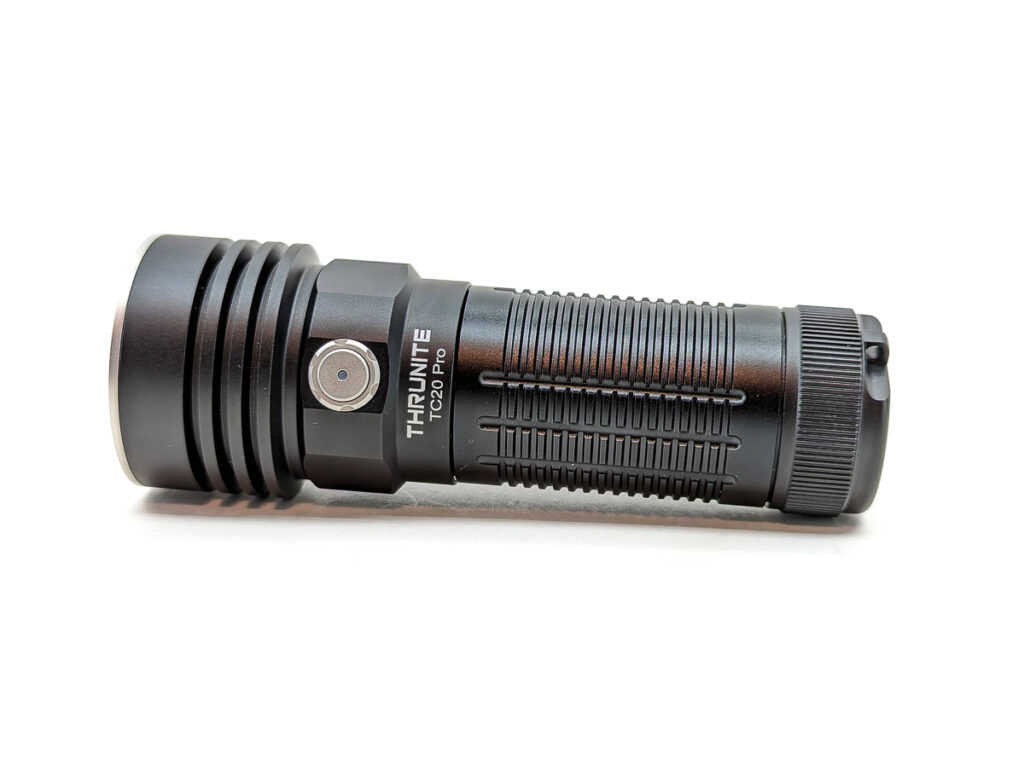
ThruNite TC20 Prospecifications
| Brand & Model | ThruNite TC20 Pro |
|---|---|
| Flashlight category | best EDC flashlight |
| LED | Cree XHP70.3 HI |
| Max. output | 3,294 lumens |
| Max. beam distance | 348 meters |
| Max. beam intensity | 30,400 cd |
| Battery config. | 1x 26650 |
| Onboard charging | USB-C |
| Modes | 5 |
| Blinkies | Strobe |
| Waterproof | IPX8 |
| Review publication date | February 2023 |
Introduction:
ThruNite has been in operation since 2009 and has put out some very nice flashlights. In fact, my very first “nice” headlamp was a ThruNite TH20 which has served me faithfully for the past 5 years. I feel like ThruNite products sit in a comfortable “in between” segment: they’re not ultra-budget lights that skimp on features, but they usually don’t break the bank either. Overall, they provide a good mix of value and performance.
Up for review today is the brand new TC20 Pro. From what I can tell, this is the third generation of the TC20. There was the original TC20, an XHP70.2 light with micro-USB charging. Then ThruNite released the TC20 V2 with an updated body style, slightly higher output, and USB-C charging. Now we have the Pro model which ditches the XHP70.2 and orange peel reflector in favor of a XHP70.3 HI LED and smooth reflector. Being the third generation, this should be pretty good stuff, right?
Package quality.
The ThruNite TC20 Pro arrived in pretty typical packaging: a brown cardboard box with some light ThruNite branding on the outside. The inside was lined with foam. Overall, pretty understated but highly functional in making sure the goods arrive in proper order. Inside the box was:
- ThruNite TC20 Pro
- ThruNite 26650 battery
- Charging cable
- Holster
- Lanyard
- Spare o-rings
- Spare charging port covers
- Spare button gasket
- Split ring
- Manual
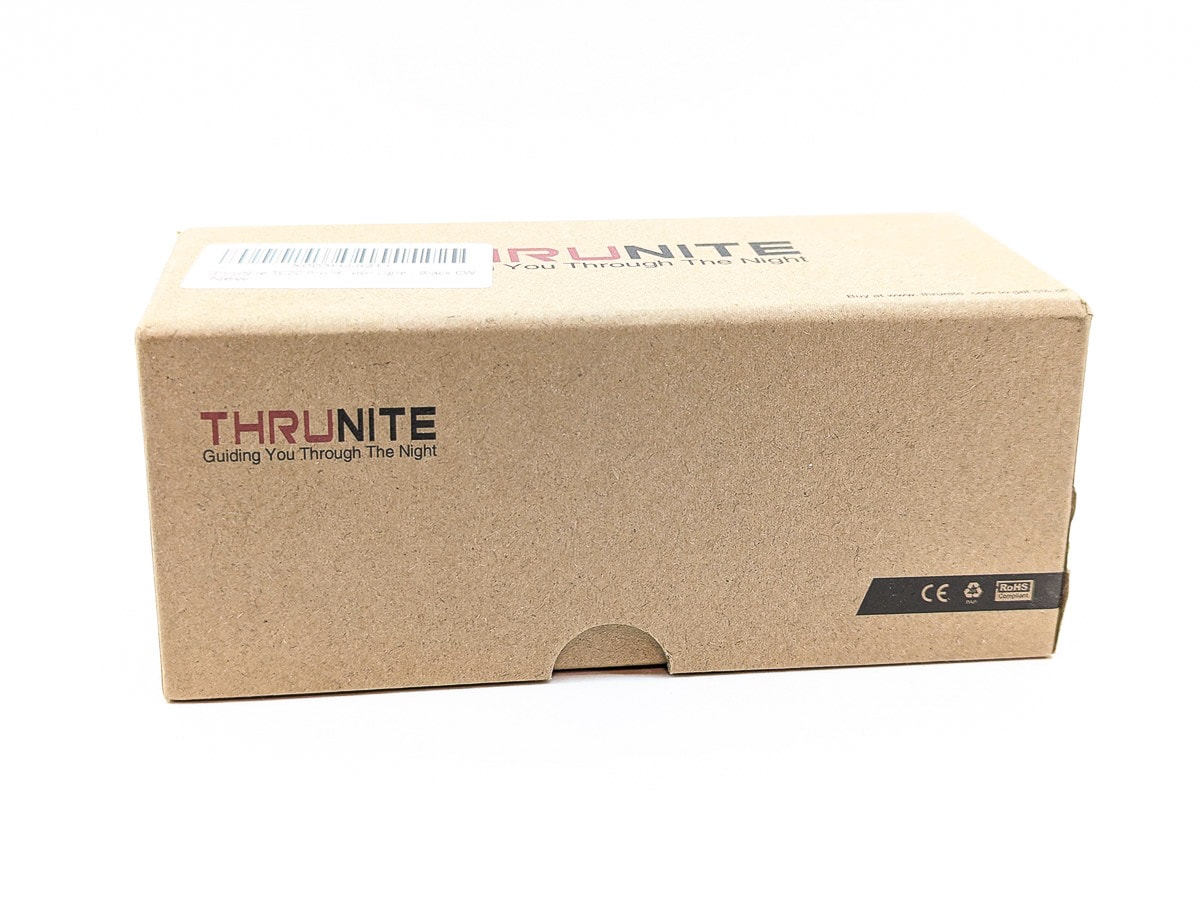


Flashlight in use
The ThruNite TC20 Pro sure seems a lot like an EDC flashlight. It’s roughly the same length as a lot of my other EDC lights sitting around, such as the Olight Baton 3 Pro Max and the Wurkkos FC13. But with it being powered by a 26650 battery, it’s a bit on the chunky side. The TC20 Pro sits comfortably in the hand, and my thumb naturally rests against the single switch (an e-switch) that’s on the side of the head. Opposite the switch is a USB-C charging port, covered by a flush rubber flap.
The tail of the light is perfectly flat. Coupled with the wider body, this light is great at tail-standing. There is no pocket clip to speak of. That’s ok, I can’t imagine putting this in my pants pocket. It would definitely fit in a jacket pocket, no problem. And it comes with a nice holster if you want to keep it riding on your hip. The lanyard has ThruNite branding and seems pretty nice. The lanyard attachment point is the only complaint I have about the body of the light – it has a slightly sharp edge to it, a chamfer would have been nice.
Like I was saying, the ThruNite TC20 Pro seems to be an EDC light (if a bit thick) and would do great in your jacket pocket, the holster, or in your hand. With the new XHP70.3 HI LED, you might also call this a small searchlight. Whatever you want to call it, I think it would be great for hiking, camping, hunting, and general household / outdoors activities. It puts out a lot of light in a reasonably small form factor and has a moderate amount of throw.
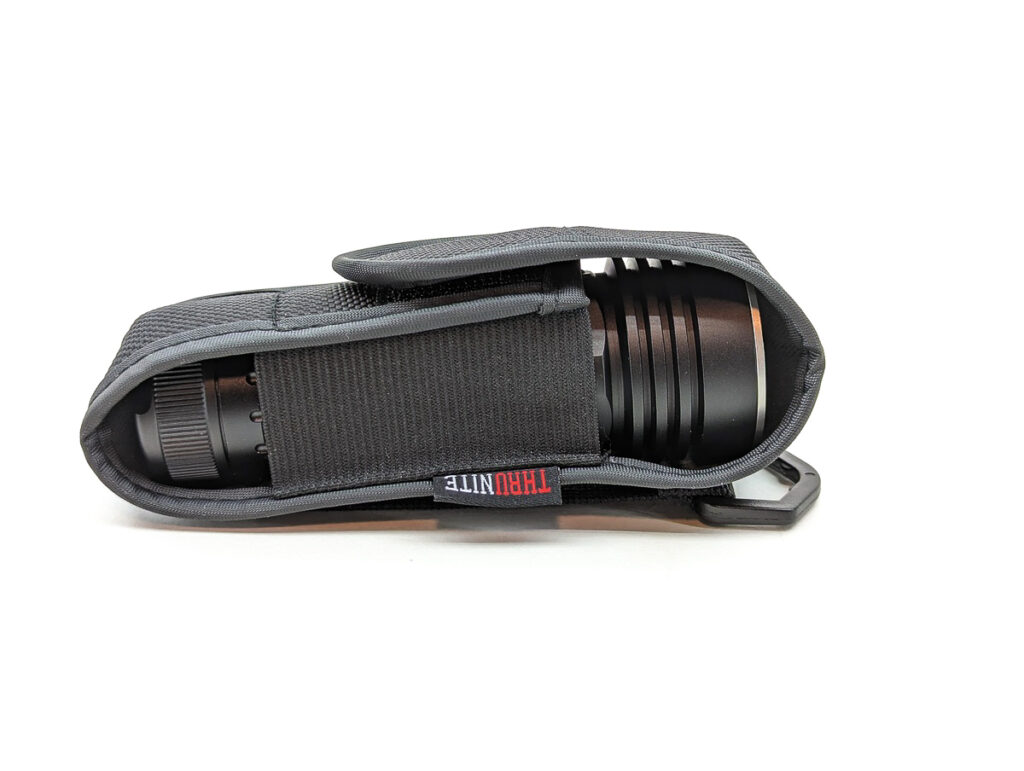
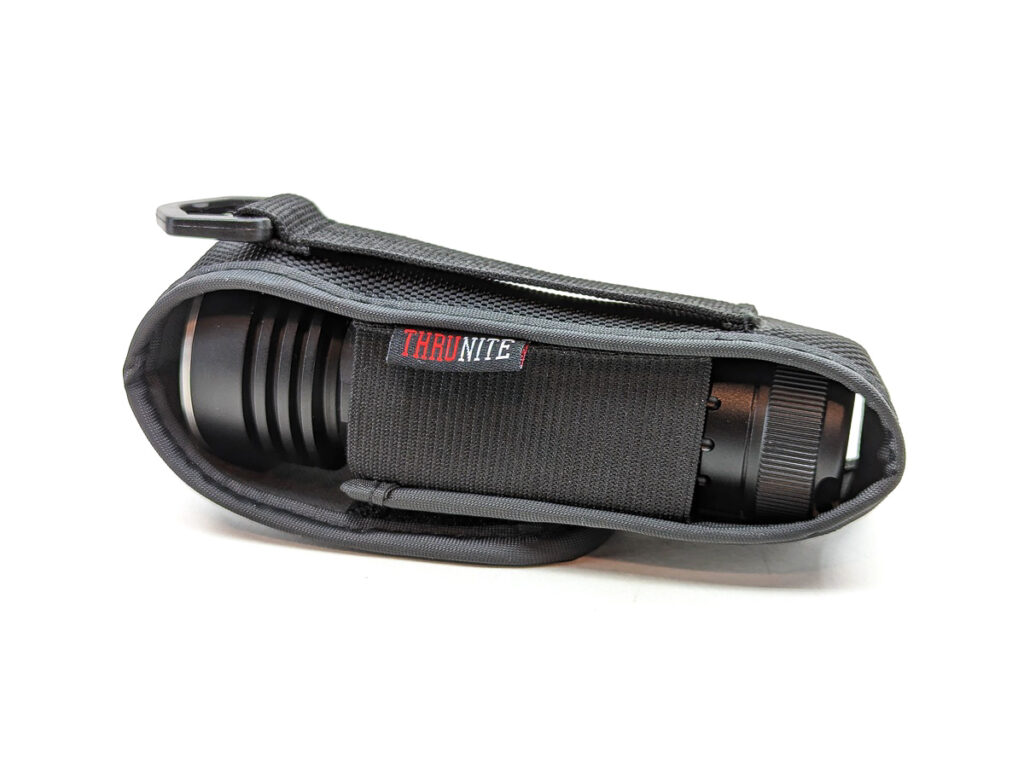
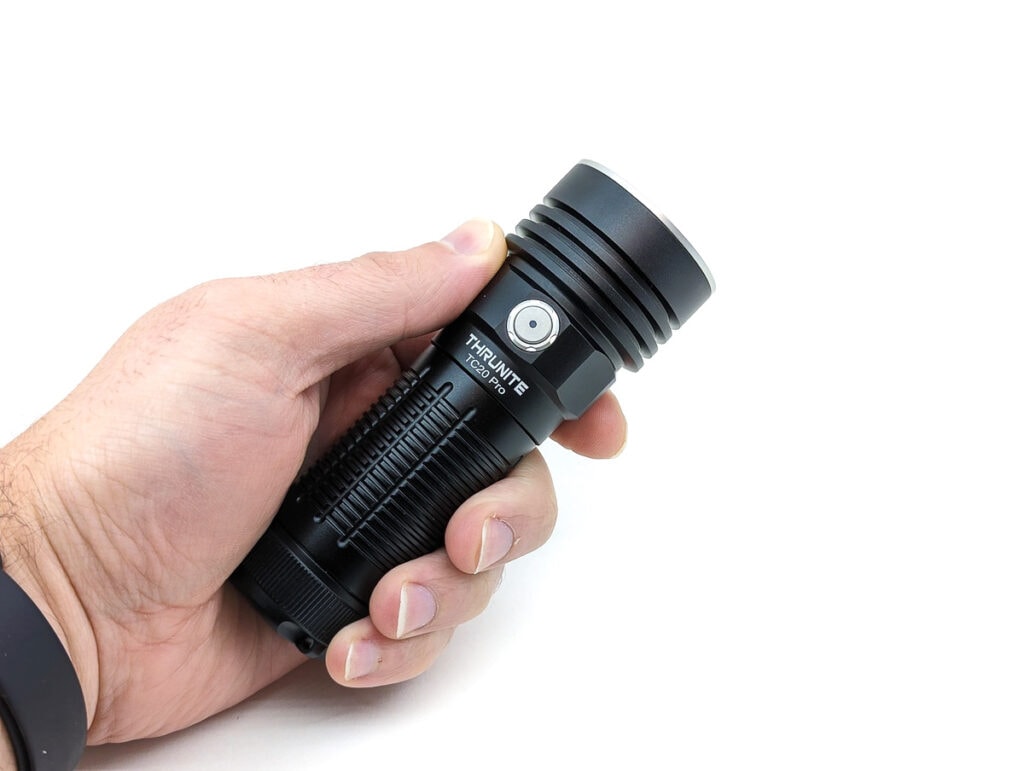
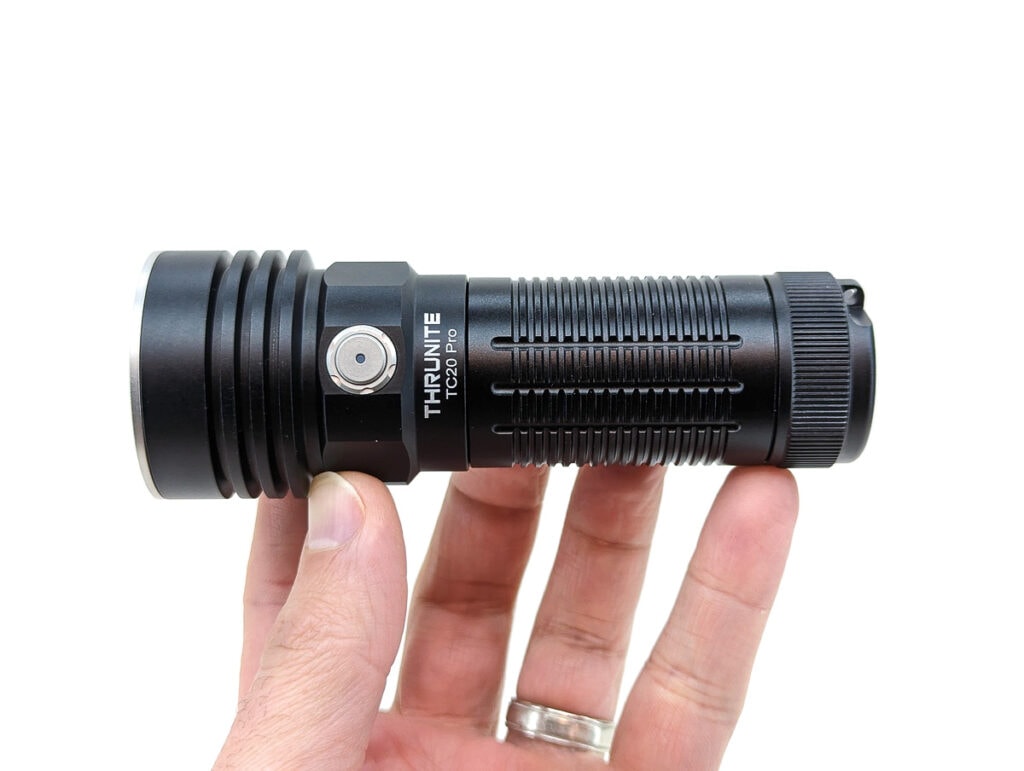
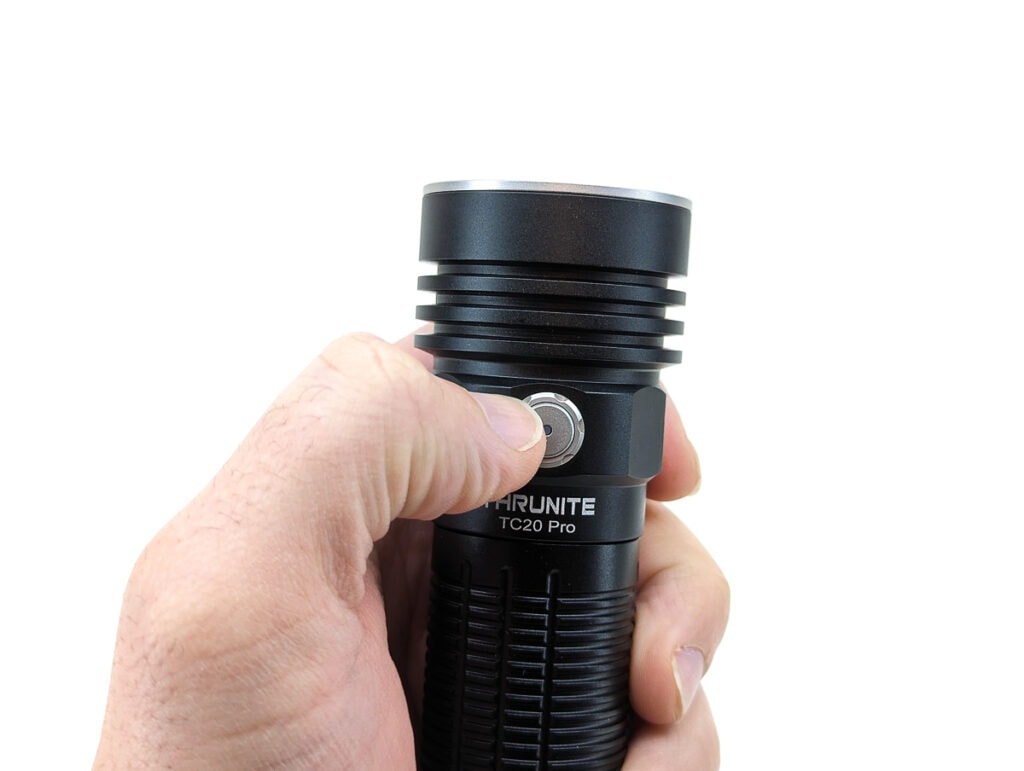
Build Quality and Warranty
The TC20 Pro is predominantly made out of aluminum which is covered in premium Type III Hard-Anodized finish. I would say the black coating has a “satin” sheen to it. The majority of the body tube is covered with rings that run all the way around and a few channels running lengthwise. There is no traditional knurling. The tailcap is covered in reeding to aid in removal.
The bezel and button are made of matching stainless steel. The button is pretty much the one and only quibble I have about this flashlight. For some reason, if you have much sideways pressure when activating the button, it can get stuck in. It’s easy to get the button unstuck, and it can be avoided by making sure you put even pressure on the center of the button. I feel that it would probably get better with time as the light “breaks in”, but since I’ve only been using the TC20 Pro for a couple of weeks, I can’t say for sure.
Warranty:
- 30 days refund from Amazon (if you bought it on Amazon)
- 2 years free replacement from issues brought on by normal use
- Limited lifetime maintenance (cost of parts and shipping covered by the customer)
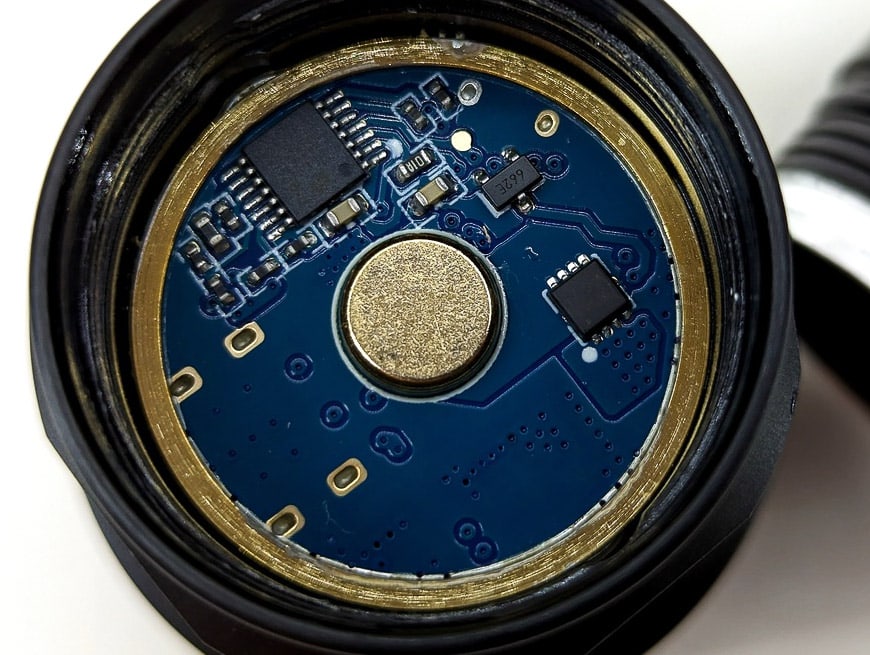

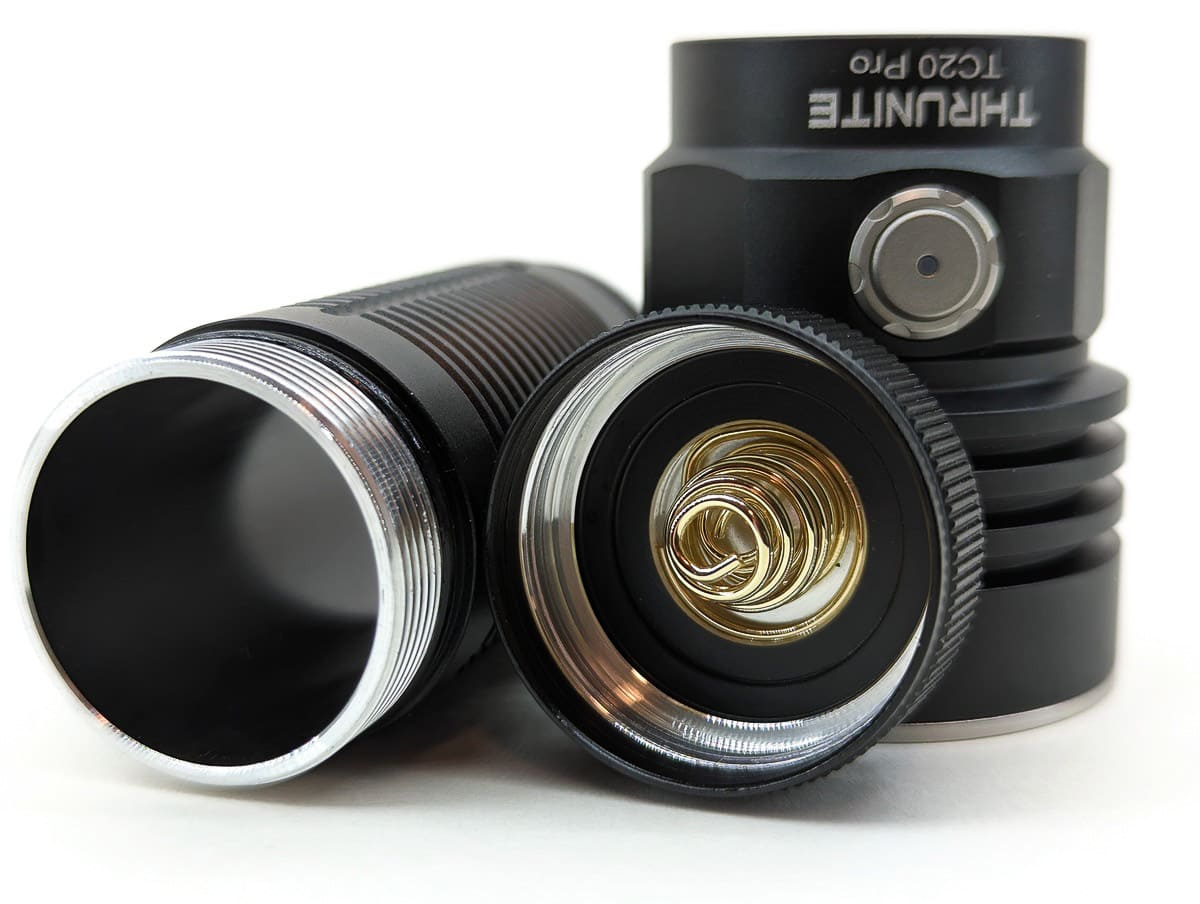
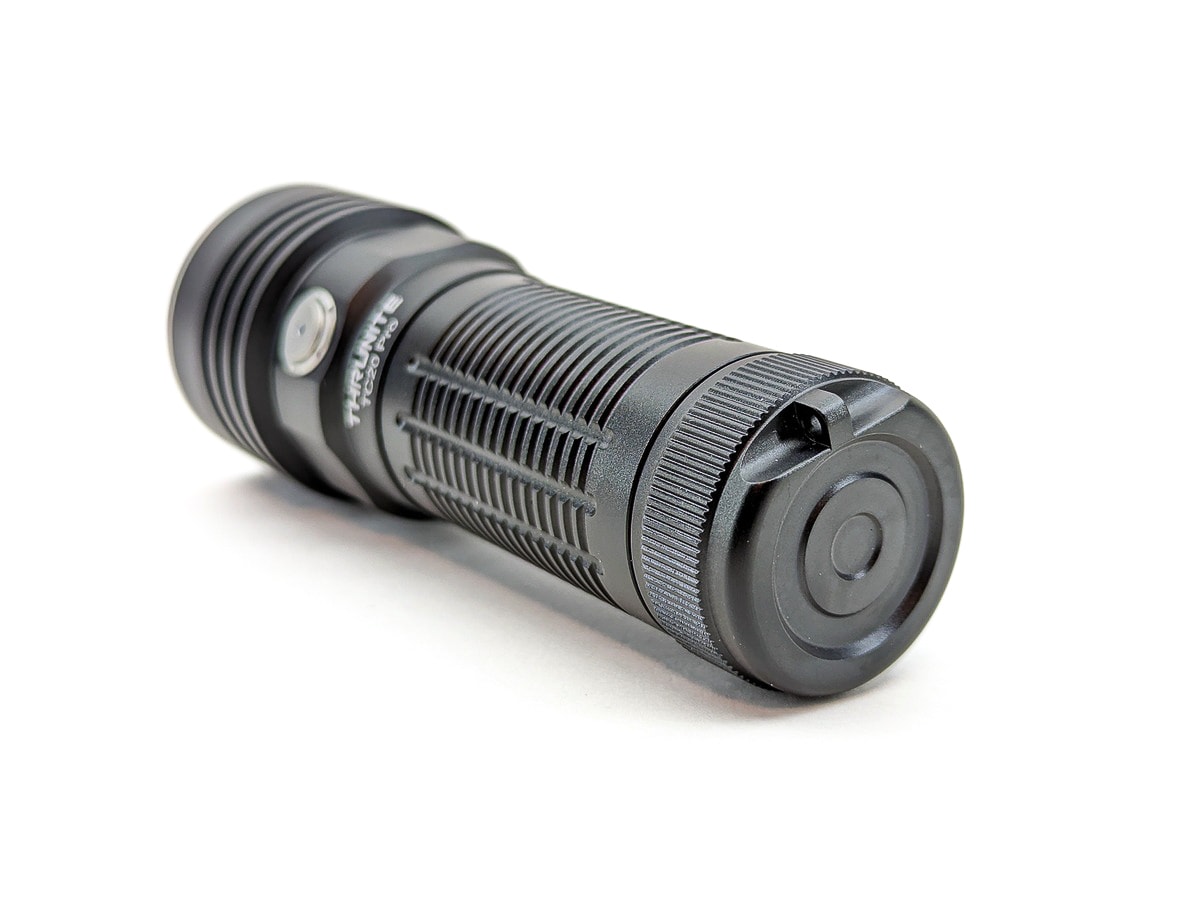
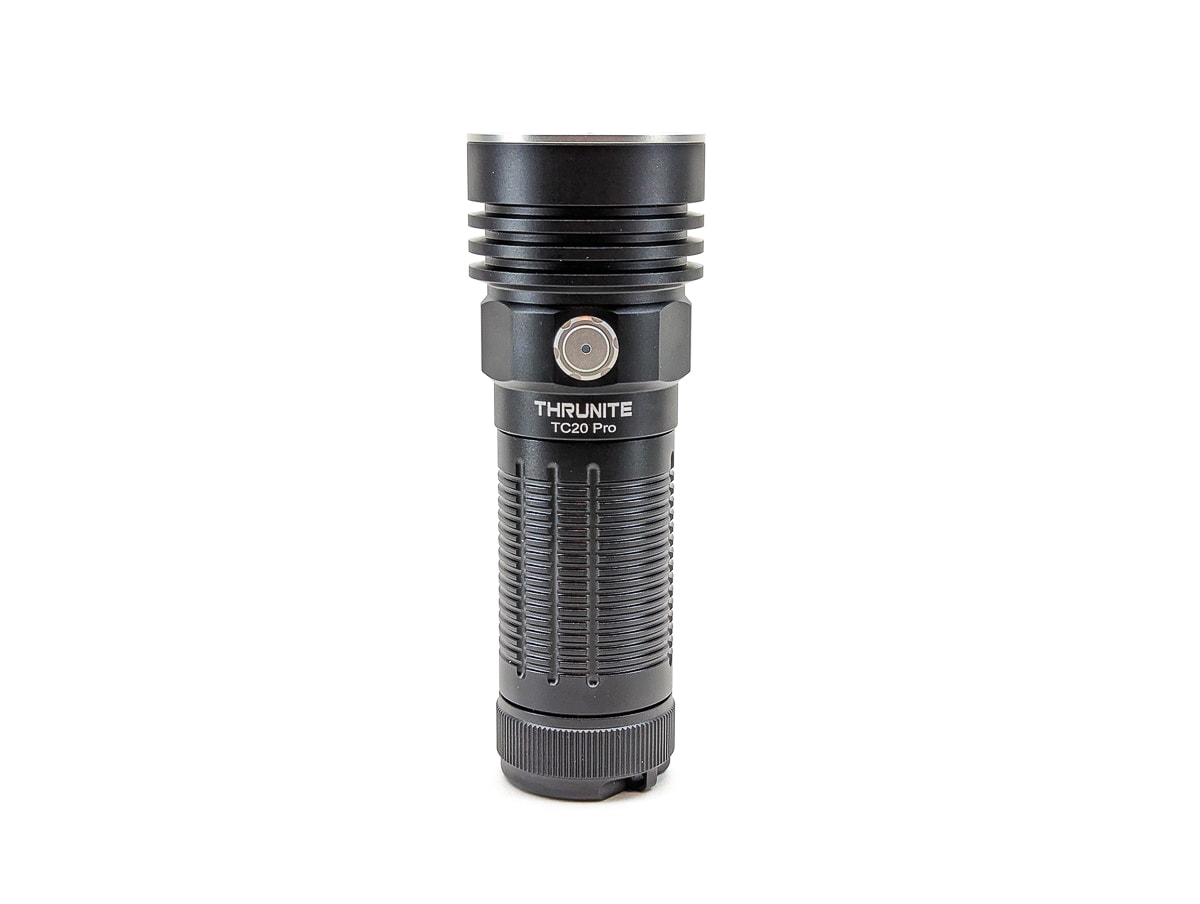
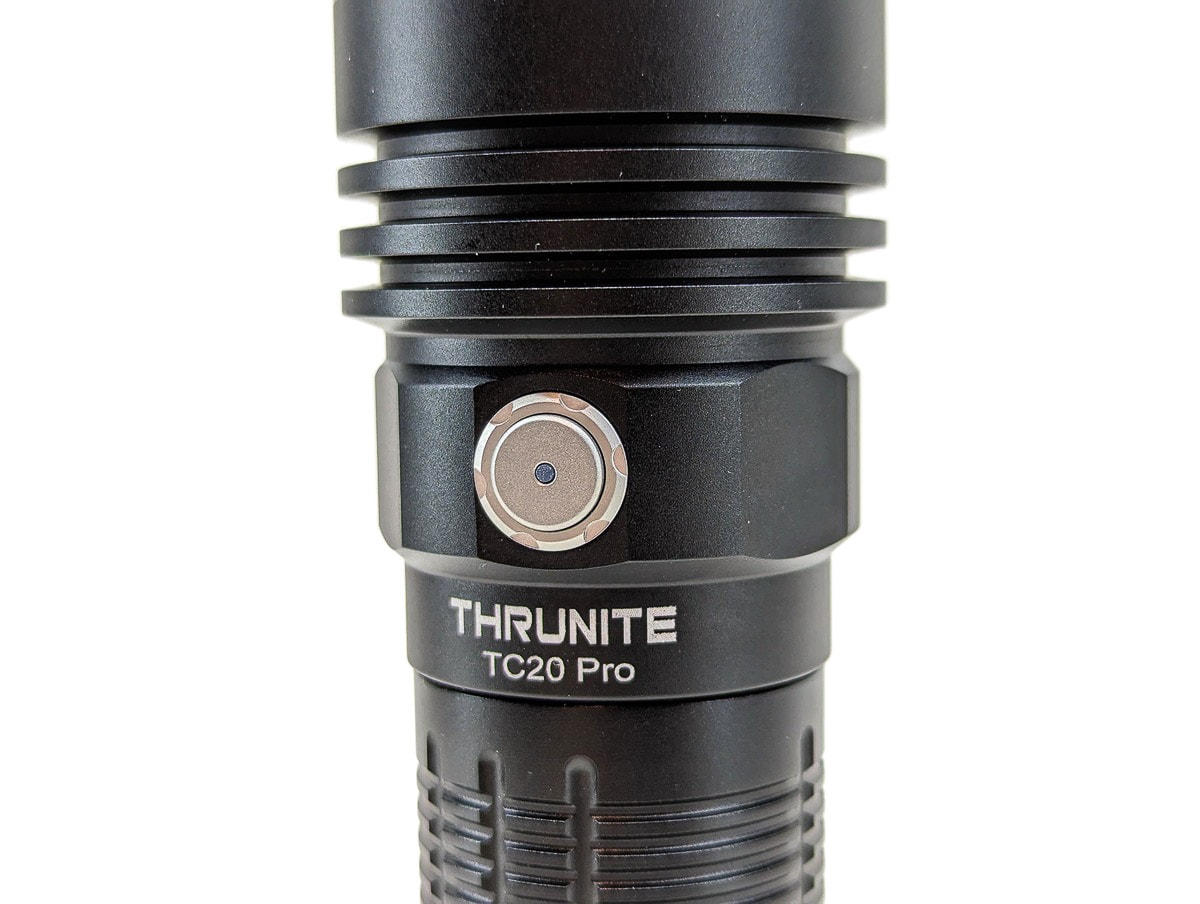
LED, Lens, Bezel, Beam, and Reflector
Around the front of the ThruNite TC20 Pro, you’ll find that nice smooth stainless steel bezel. That’s holding an anti-reflective piece of glass in place. Under that is a smooth reflector now, in which is centered a new Cree XHP70.3 HI LED. That’s “HI” as in “High Intensity” – an LED that comes domeless from the Cree factory.
The Cree XHP70 has always been enticing for flashlight enthusiasts, but not without its drawbacks. The XHP70 is a quad-die LED, made up of 4 of the same dies you’ll find in the XP-L LEDs (or XP-L2, etc). While having 4 dies means you can get a lot of output, the first version of the LED had too much of a gap between the dies which created a noticeable “donut hole” effect for a lot of flashlights. The second generation of XHP70 (the XHP70.2) arrived to address that issue: the dies were much closer and now completely covered by a continuous pour of phosphor. The donut hole was nearly eliminated but then a new problem arose: that full-pour phosphor flip-chip design had some terrible tint shift.
That LED is what was in both of the first two generations of the TC20. Those featured an orange peel reflector which can help mitigate that aberration, but there was only so much that could be done. That’s why it is a great relief to see that ThruNite went with the new Cree XHP70.3 HI LED. The dies are close together and the phosphor only covers the dies, eliminating almost all of the tint shift. And being the HI version, there’s no dome, which can mean an even cleaner beam and a more intense one (that is, it “throws” better). With the improvements to the LED, ThruNite was able to go with a smooth reflector, which further increased the intensity of the beam. The beam has a fairly tight hotspot that fades into a very wide spill.
Measurements from the Opple Light Master, Turbo at 5 meters:
- CCT: 6267K
- CRI: 70.0 Ra
- DUV: +0.0049
Sure, it’s only a 70-CRI LED and the DUV is slightly positive. But overall, I find the beam to be very pleasing and versatile.
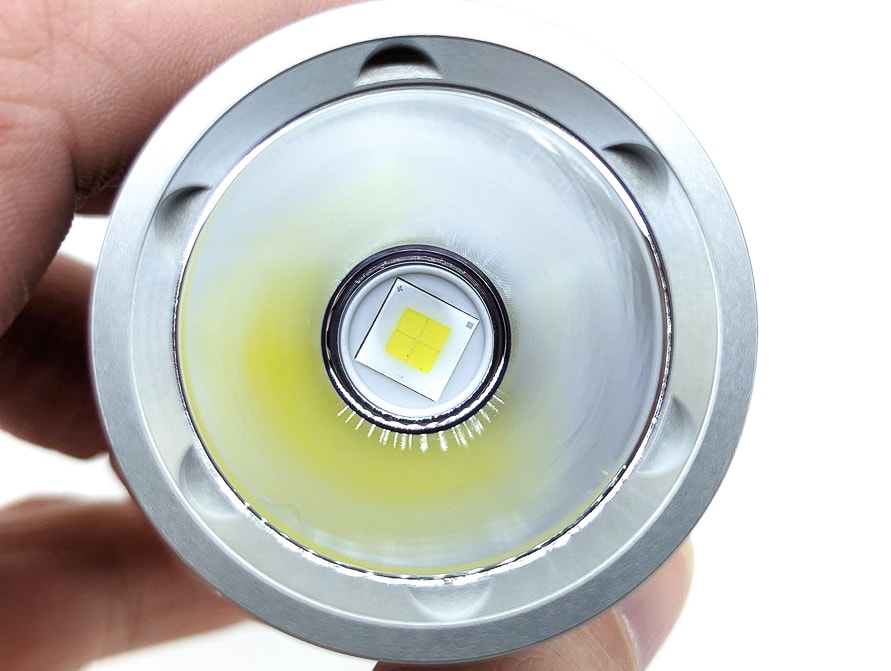
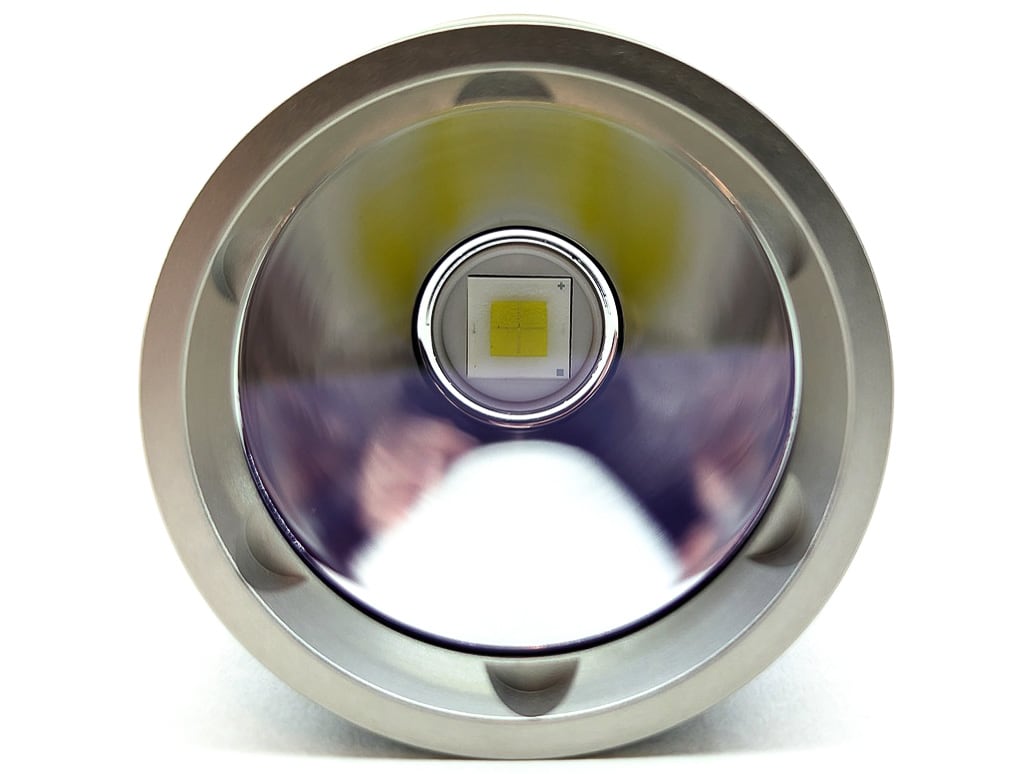
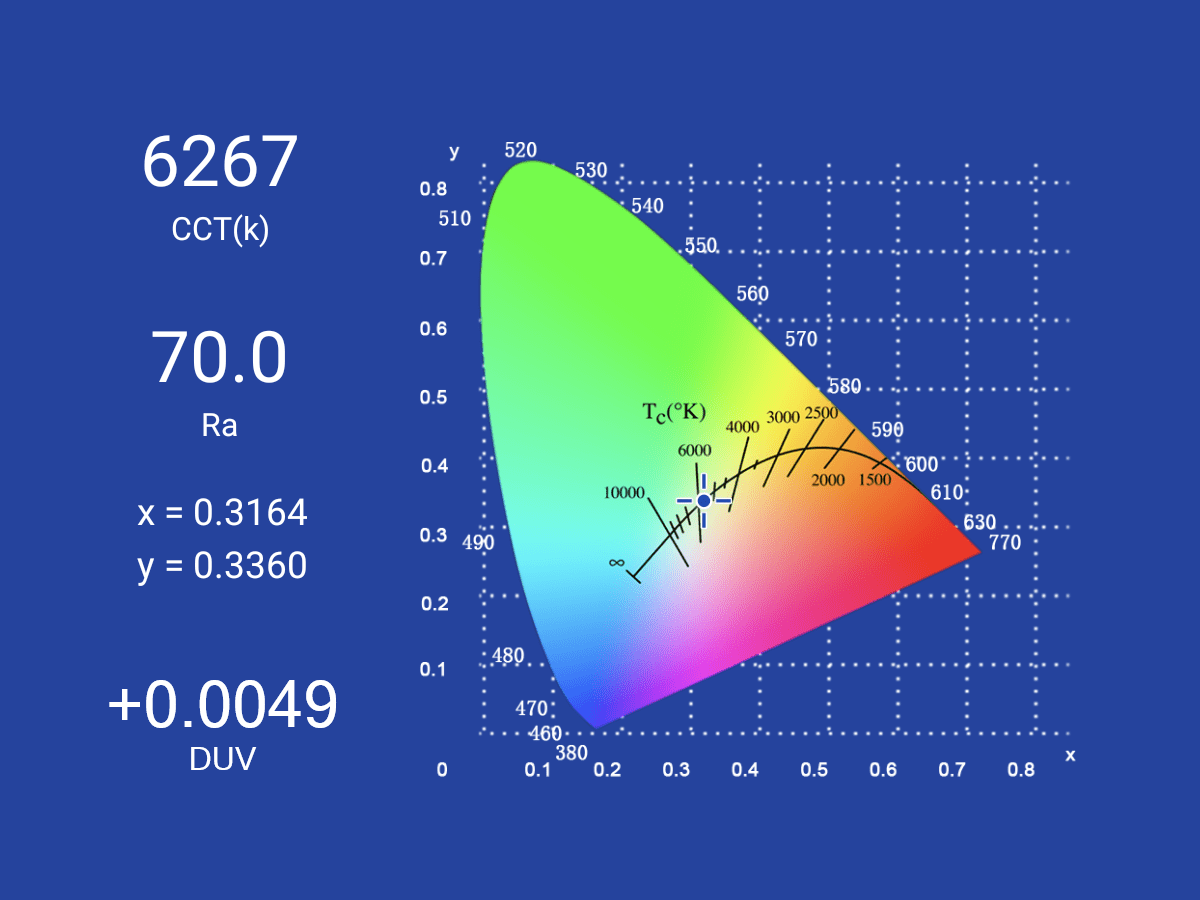
Dimensions and its competition
Dimensions:
| ThruNite TC20 Pro | Millimeters | Inches |
|---|---|---|
| Length | 119 mm | 4.7 in |
| Head diameter | 42 mm | 1.7 in |
| Body diameter | 34 mm | 1.3 in |
Dimensions are rounded to the nearest millimeter, and to the nearest tenth of an Inch.
Weight:
| ThruNite TC20 Pro | Weight in grams | Weight in oz |
|---|---|---|
| Without battery: | 141 g | 5.0 oz |
| With battery | 242 g | 8.5 oz |
Weight is rounded to the nearest gram, and to the nearest tenth of an Oz.
Flashlight size comparison with its competition:
Group 1: Astrolux MF01 Mini, ThruNite TC20 Pro, Astrolux EC01
Group 2: Astrolux ST01, ThruNite TC20 Pro, Nightwatch Incredible NS73V1
Group 3 ThruNite flashlights: ThruNite T1S, ThruNite Archer 2A V3, ThruNite TC20 Pro, ThruNite TN36 Limited
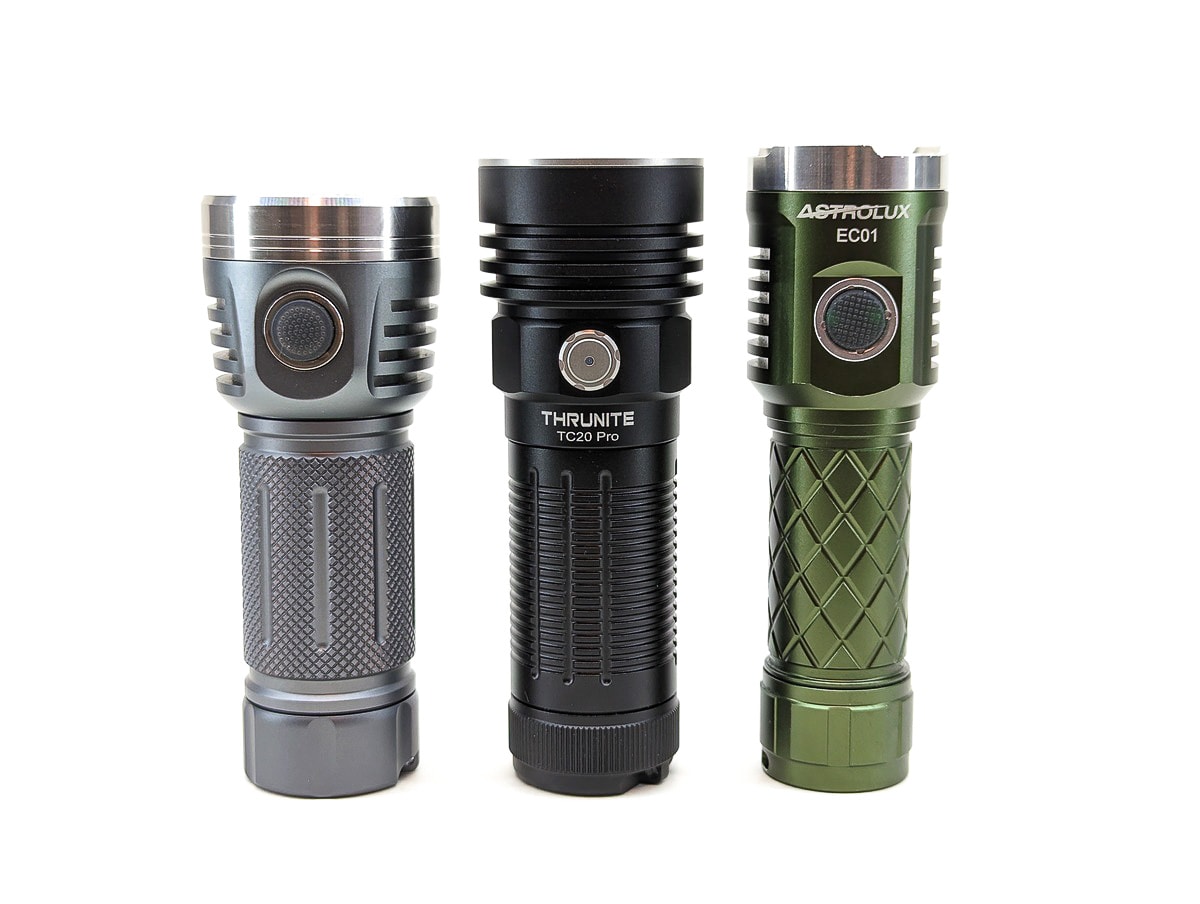
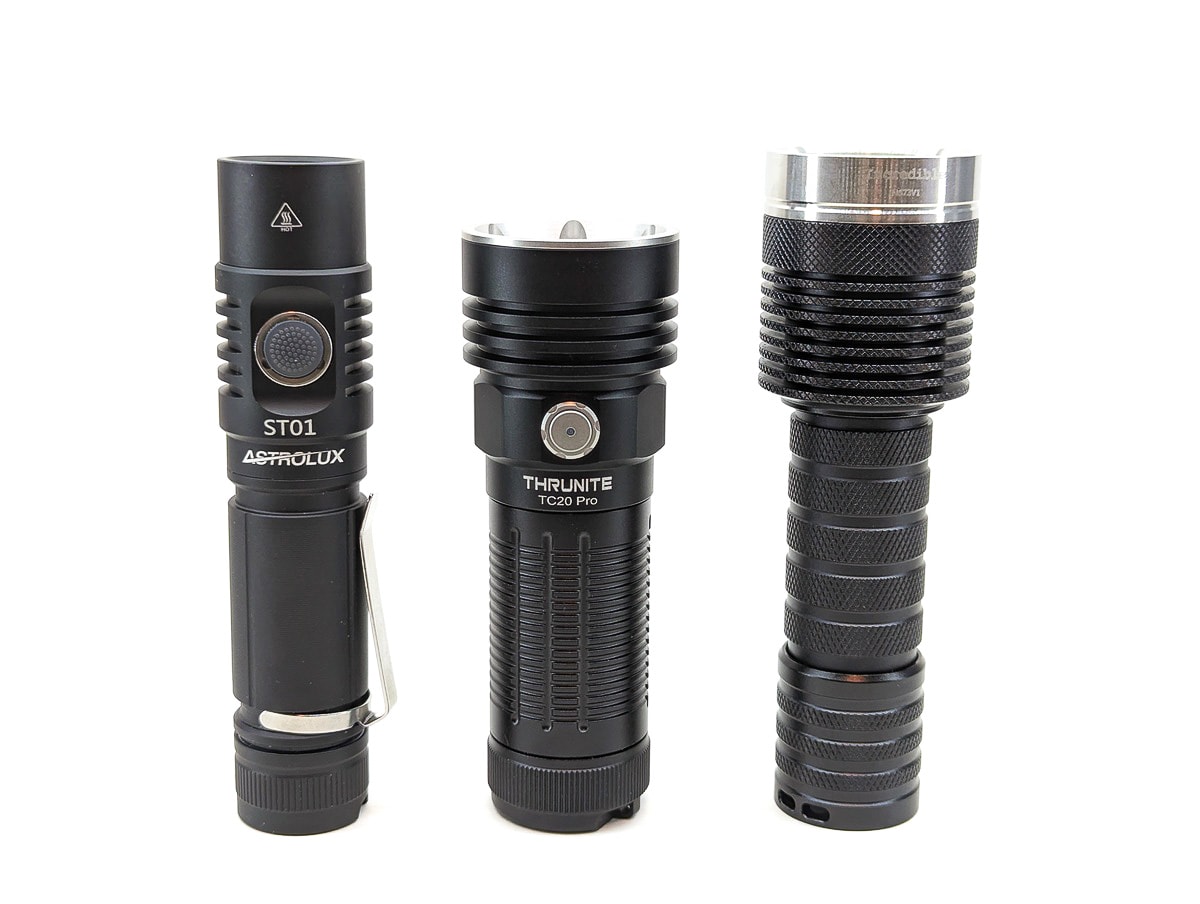

ThruNite TC20 Pro UI: User Interface and Driver
Available modes:
- Firefly, Low, Medium, High, Turbo
Available blinky modes:
- Strobe
From OFF:
- Press and hold: Firefly
- Single click: On
- Double click: Turbo
From ON:
- Press and hold: change modes (Low, Medium, High)
- 1 click: Off
- Double click: Turbo
Mode memory:
- Yes, the “normal” modes (Low, Medium, High) will be memorized
- Firefly, Turbo, and Strobe are not memorized
Shortcuts:
- To Firefly: press and hold from Off
- To Turbo: double click from any mode
- To Strobe: double click from Turbo
Low voltage warning:
- There is an indicator LED in the button that displays the remaining battery capacity (note: does not illuminate in Firefly mode)
- Blue: 21 – 100% (3.3-4.2V)
- Red: 11 – 20% (3-3.2V)
- Flashing red: 1 – 10% (2.8-3V)
- Off: 0% (0-2.8V)
Strobe/blinkies
- Double click from Turbo to activate Strobe
Lock-out mode:
- None
PWM
- None
Additional/summary info on the UI:
- A Lock-out mode would be very welcome in this light. The TC20 Pro isn’t one that you want accidentally turning on in your coat pocket, in the holster, etc. Eventually the thermal regulation would kick in, but it could get toasty for a few minutes first.
ThruNite TC20 Pro Charging and batteries
The ThruNite TC20 Pro uses 26650 batteries. This size used to be the one you’d spring for when wanting more capacity than a 18650, but these days it seems to have fallen out of favor for the new darling-child, the 21700.
It’s still a very nice battery, just not as common as it once seemed to be. The included cell is a ThruNite-branded 5000 mAh battery with an integrated protection circuit. The positive pole is just slightly proud of the battery, but not what I would consider to be a button top. I compared it to a Shockli 5500 mAh cell that I had on hand and the ThruNite, with its protection circuit, is expectedly a bit longer. The Shockli still worked in the TC20 Pro thanks to the nice double springs in the tailcap.
Charging is handled through a USB-C port on the side of the head, opposite the switch. I observed a charge rate of 10.2 watts (2.0 amps at 5.1 volts). A complete charge cycle was completed in 3 hours and 6 minutes, having transferred 23.8 wh of power. The ending voltage was 4.16 volts. The indicator LED illuminates red while charging and turns to blue when done.
You can use the TC20 Pro while charging, though only in Firefly, Low, and Medium modes.
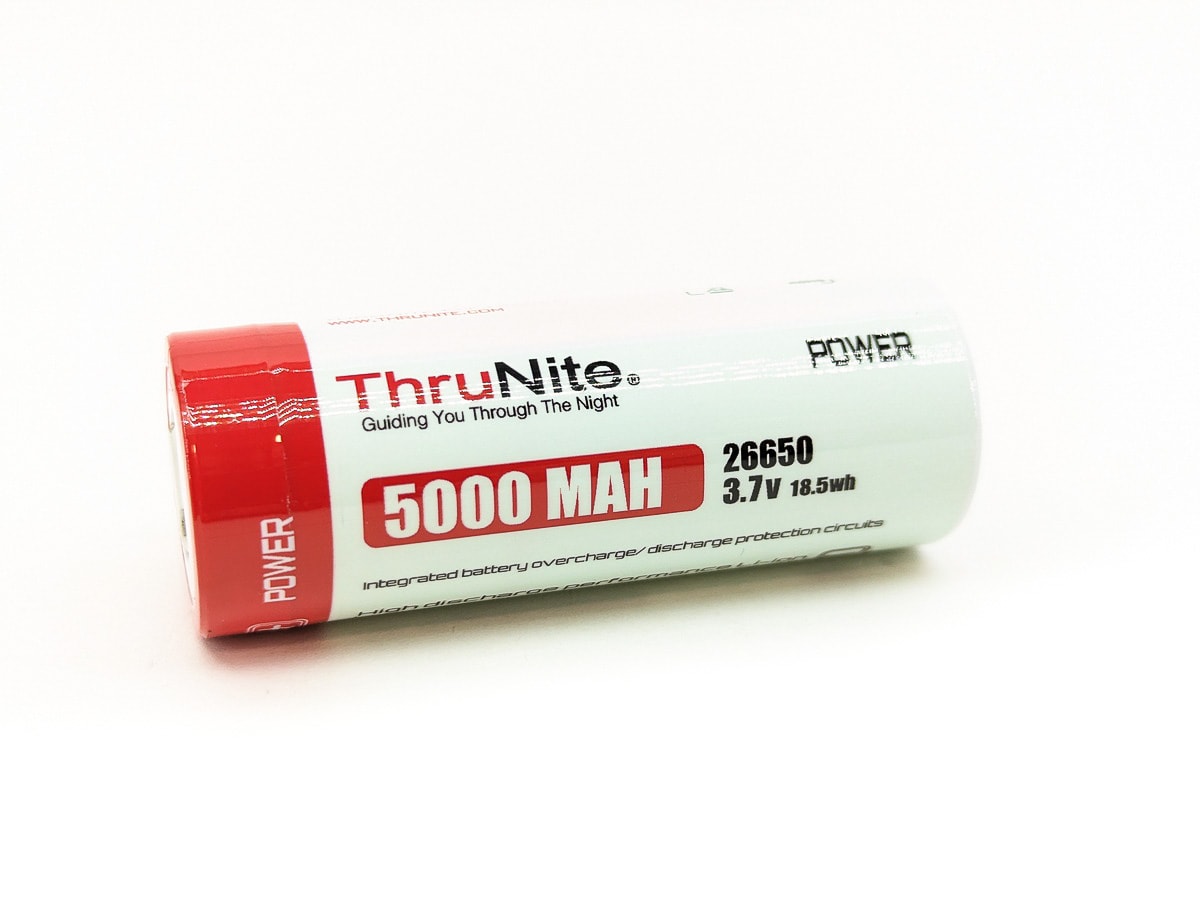
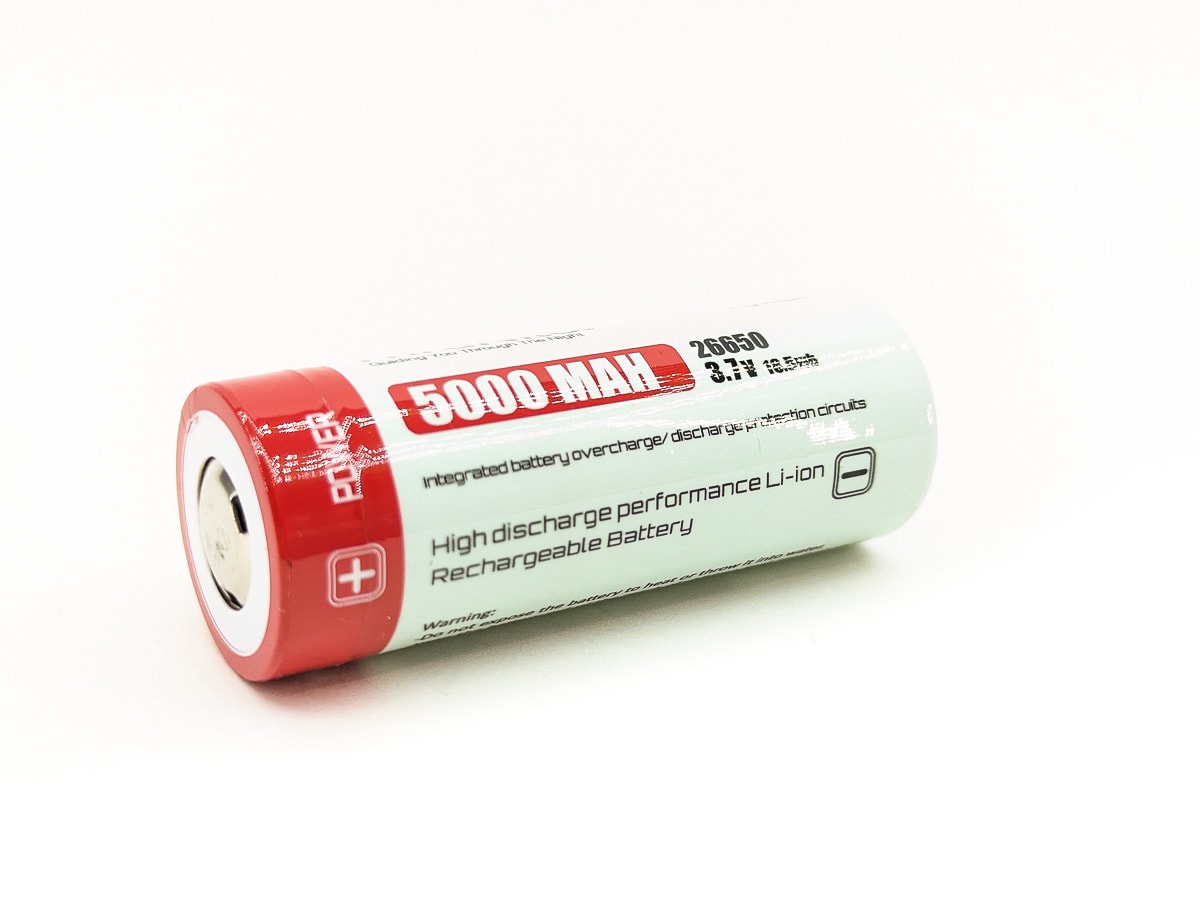


Performance test
Lux was measured by a UNI-T UT383 BT at 5 meters. Lumens were measured in a homemade lumen tube using a VEML7700 sensor, calibrated with a Maukka calibration light. The included ThruNite battery was used for testing.
Lumen measurements (for each mode)
| Mode | Amps at start | Specified | turn on | 30 sec | 10 minutes |
|---|---|---|---|---|---|
| Firefly | 3 mA | 0.4 | 0.7 lm | 0.7 lm | – |
| Low | 60 mA | 30 | 34 lm | 34 lm | – |
| Med | 550 mA | 264 | 354 lm | 352 lm | 350 lm |
| High | 3.5 A | 1513 | 1993 lm | 1967 lm | 1853 lm |
| Turbo | 8.5 A | 3294 > 1500 | 3587 lm | 3454 lm | 1920 lm |
| Turbo at 3.6V | – | – | 2659 lm | 2576 lm | – |
Parasitic drain:
- 87 µA, not terribly high, but a little higher than expected for it not having any aux LEDs
As I would expect from ThruNite, the output numbers are well within spec. They’re actually slightly higher than the lumen claims. I was beginning to get a bit worried about the temperature of the flashlight in both the Turbo and the High tests. The temperature climbed to around 75°C and I was getting ready to turn on a fan to cool the light off when it stepped down on its own, presumably because of the high heat. It was still a bit hotter than I prefer, but if you don’t like the heat… turn the light down to a lower mode.
Battery Life: Runtime graphs

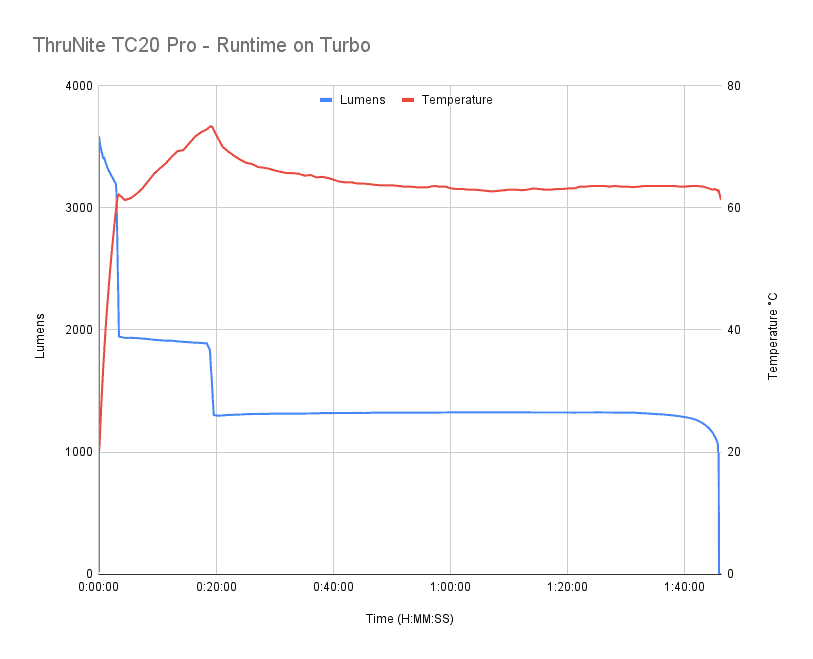
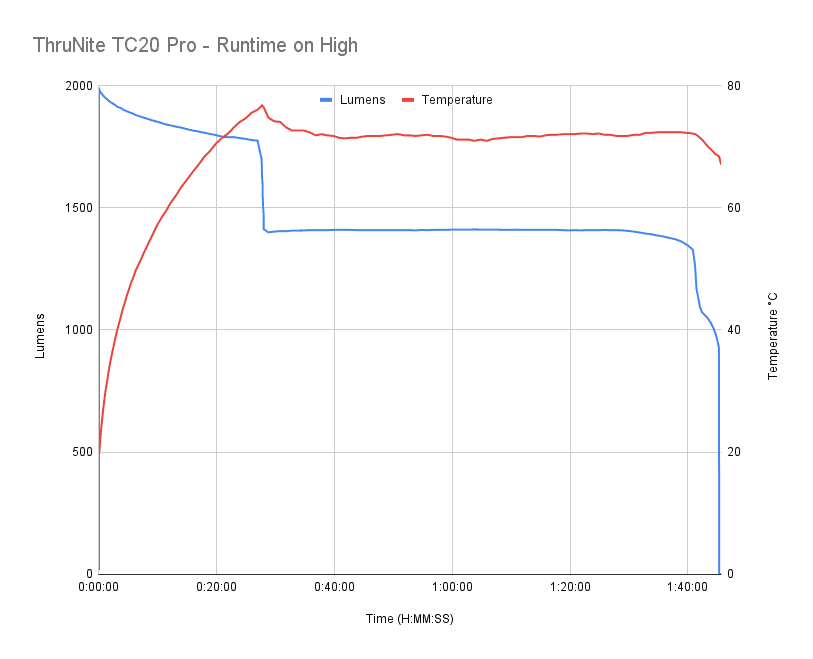
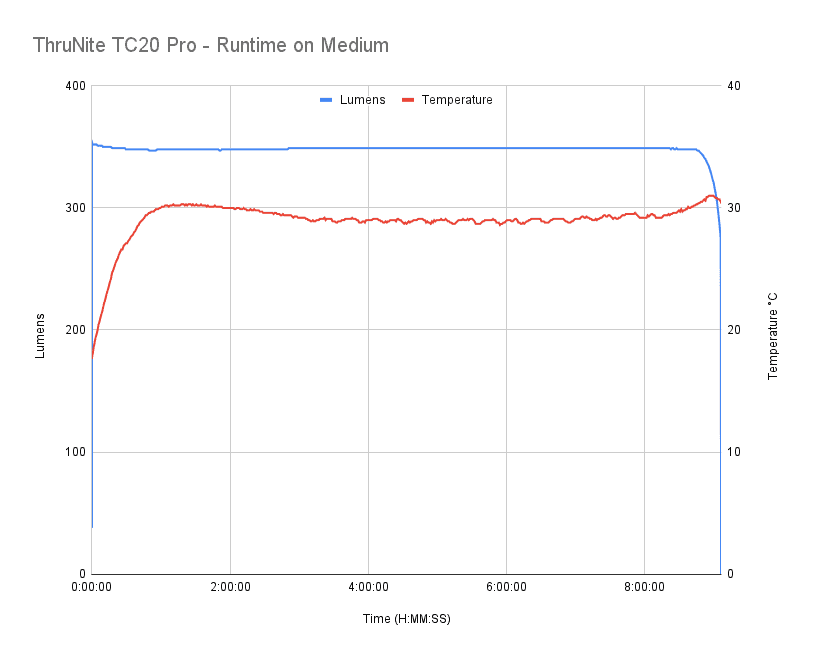
| Mode | Specified | Measured runtime ANSI | Time till shut off |
|---|---|---|---|
| Firefly | 69 days | – | – |
| Low | 89h | – | – |
| Med | 10h 30min | 9h 6min | 9h 6min |
| High | 1h 56min | 1h 45min | 1h 45min |
| Turbo | 200s > 1h 52min | 1h 46min | 1h 46min |
In general, the runtimes from my test are really close to what ThruNite claims for the TC20 Pro. The Medium test was a bit shorter than spec, but I attribute that to the higher output than what ThruNite said to expect for that mode.
About ANSI FL1 standards: The runtime is measured until the light drops to 10% of its initial output (30 seconds after turning on). This does not mean that the flashlight is not usable anymore. The last column shows how long the light actually works till it shuts off. If there is a + symbol, it means that the test was stopped at that particular point, but the light was actually still running. This happens on certain occasions, with certain drivers, firmware, or batteries.
Peak beam intensity and beam distance measurements
Intensity was measured at 5 meters after being turned on for 30 seconds. A UNI-T UT383 BT lux meter was used.
| Mode | Specified | Candela measured | Meters | Yards |
|---|---|---|---|---|
| Low | – | 425 cd | 41 m | 45 yd |
| Medium | – | 3,625 cd | 120 m | 131 yd |
| High | – | 20,750 cd | 288 m | 315 yd |
| Turbo | 30,400 cd | 37,250 cd | 386 m | 422 yd |
Again, I’m measuring a bit above the intensity spec, which is nice.
About peak beam intensity: Peak beam distance according to ANSI FL1 standards: The calculated value of distance in meters at which the flashlight produces a light intensity of 0.25 lux. (0.25 lux is about the brightness of a full moon shining on an object). The columns ‘Meters’ and ‘Yards’ use rounded numbers.
Beamshots
Camera settings and distance:
Beam shots of the building are taken at 30 m (33 yd) using a Pixel 7 set to ISO 800 with 1/10 second exposure time
Beamshots of the following flashlights compared:
- ThruNite TC20 Pro
- Olight Baton 3 Pro Max
- Sofirn SP35
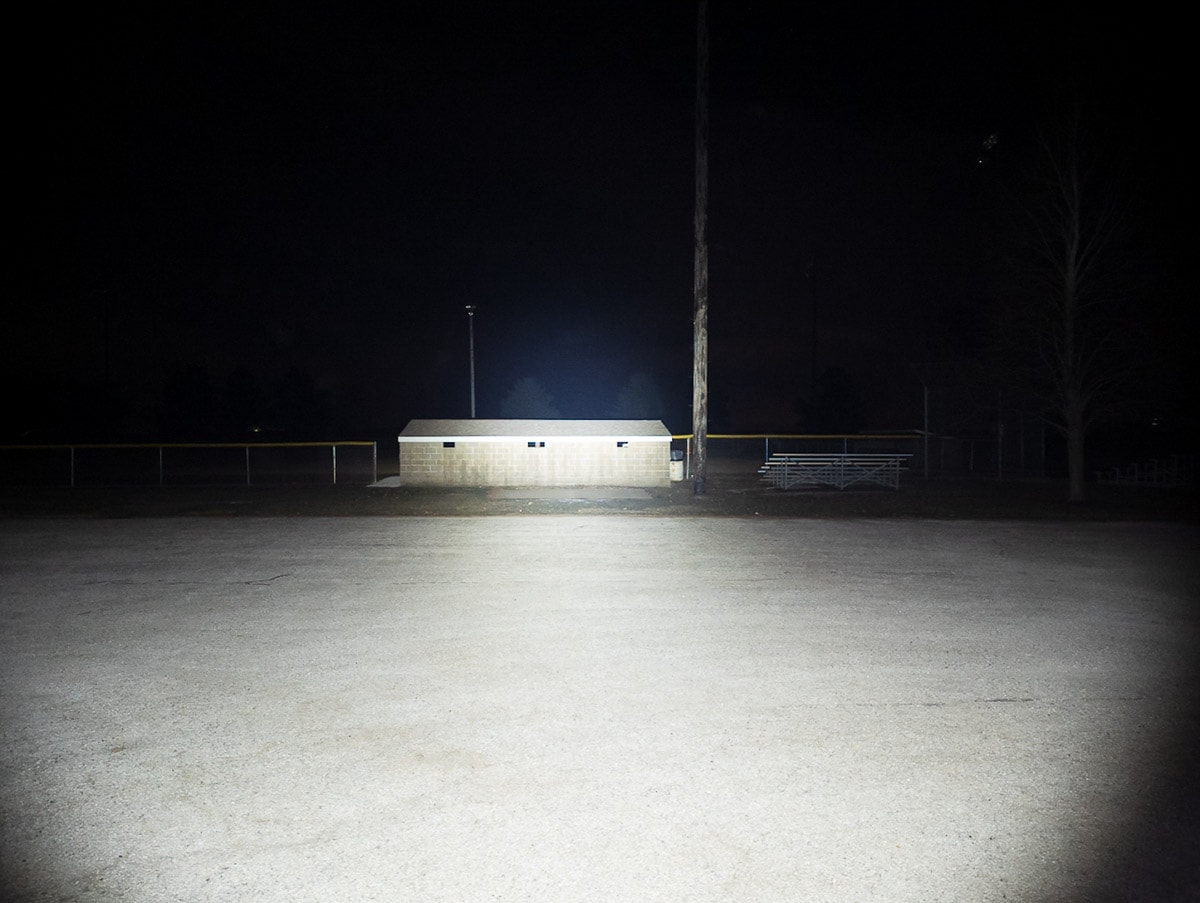
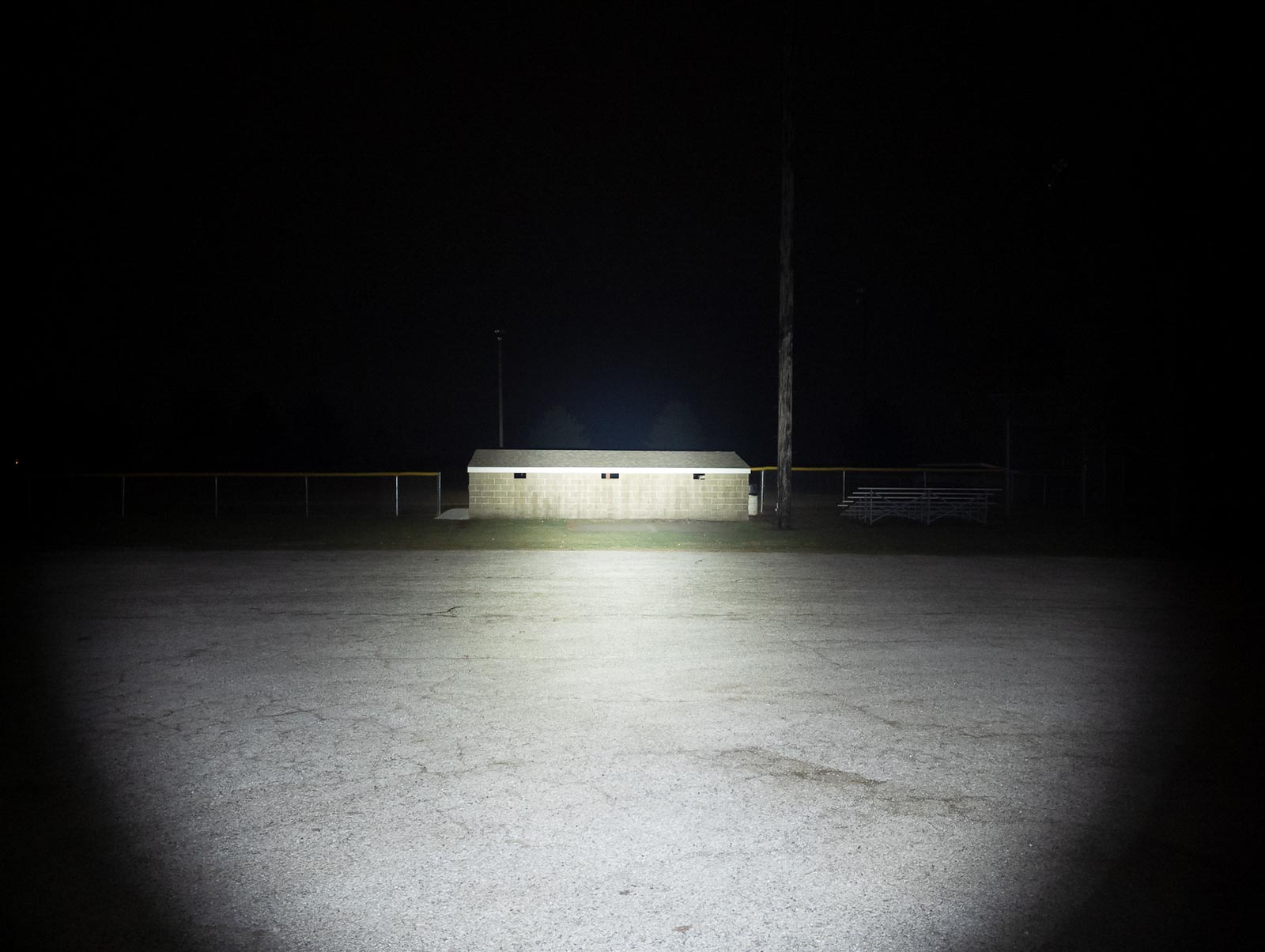

Disclaimer: This flashlight was sent to me for review at no cost by ThruNite. I have not been paid to review, nor have I been holding back on problems or defects.
Final Verdict
Pros
- Nice, balanced beam
- Simple but versatile UI
- Can sustain high output
- USB-C charging
- Overall good build quality
Cons
- Sticky button
- Thick for an EDC
- No lockout mode
Explanation on star ratings:
1: Avoid: a match would be a better choice – 2: Poor: significant defect or issues; almost unusable – 3: Average: some defects or issues; but still usable 4: Good: recommended (minor issues) – 5: Great: highly recommended

4.5 stars: ★★★★⋆
I really enjoyed my time with the ThruNite TC20 Pro. It seems like a great, all-around light. The TC20 Pro makes around 3500 lumens and produces a clean beam that’s a good balance between flood and throw. The interface is a cinch to use, yet has all of the shortcuts I want. With USB-C charging and a generally nice build quality, it should be both convenient and dependable. I’m not sure what’s up with the sticky button on mine – it’s not what I consider typical from ThruNite and if it was truly an issue I’m sure they would make it right. If the wide body from the 26650 battery doesn’t bother you, I highly recommend the ThruNite TC20 Pro!
Buy ThruNite TC20 Pro here:
1lumen selects and reviews products personally. We may earn affiliate commissions through our links, which help support our testing.